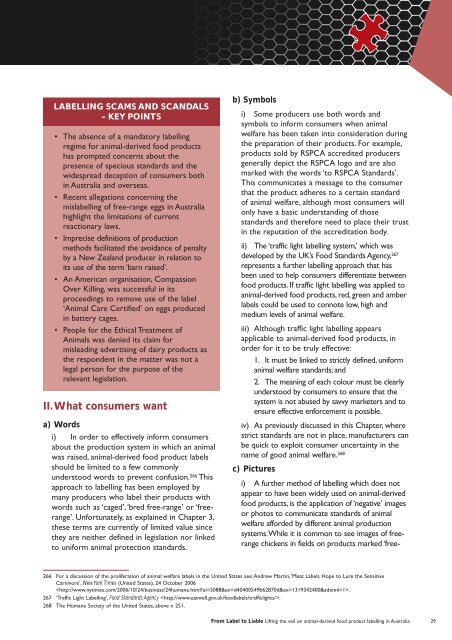From Label to Liable: Scams, Scandals and Secrecy - Voiceless
From Label to Liable: Scams, Scandals and Secrecy - Voiceless
From Label to Liable: Scams, Scandals and Secrecy - Voiceless
Create successful ePaper yourself
Turn your PDF publications into a flip-book with our unique Google optimized e-Paper software.
LABELLING SCAMS AND SCANDALS<br />
– KEY POINTS<br />
• The absence of a m<strong>and</strong>a<strong>to</strong>ry labelling<br />
regime for animal-derived food products<br />
has prompted concerns about the<br />
presence of specious st<strong>and</strong>ards <strong>and</strong> the<br />
widespread deception of consumers both<br />
in Australia <strong>and</strong> overseas.<br />
• Recent allegations concerning the<br />
mislabelling of free-range eggs in Australia<br />
highlight the limitations of current<br />
reactionary laws.<br />
• Imprecise definitions of production<br />
methods facilitated the avoidance of penalty<br />
by a New Zeal<strong>and</strong> producer in relation <strong>to</strong><br />
its use of the term ‘barn raised’.<br />
• An American organisation, Compassion<br />
Over Killing, was successful in its<br />
proceedings <strong>to</strong> remove use of the label<br />
‘Animal Care Certified’ on eggs produced<br />
in battery cages.<br />
• People for the Ethical Treatment of<br />
Animals was denied its claim for<br />
misleading advertising of dairy products as<br />
the respondent in the matter was not a<br />
legal person for the purpose of the<br />
relevant legislation.<br />
II. What consumers want<br />
a) Words<br />
i) In order <strong>to</strong> effectively inform consumers<br />
about the production system in which an animal<br />
was raised, animal-derived food product labels<br />
should be limited <strong>to</strong> a few commonly<br />
unders<strong>to</strong>od words <strong>to</strong> prevent confusion. 266 This<br />
approach <strong>to</strong> labelling has been employed by<br />
many producers who label their products with<br />
words such as ‘caged’,‘bred free-range’ or ‘freerange’.<br />
Unfortunately, as explained in Chapter 3,<br />
these terms are currently of limited value since<br />
they are neither defined in legislation nor linked<br />
<strong>to</strong> uniform animal protection st<strong>and</strong>ards.<br />
b) Symbols<br />
i) Some producers use both words <strong>and</strong><br />
symbols <strong>to</strong> inform consumers when animal<br />
welfare has been taken in<strong>to</strong> consideration during<br />
the preparation of their products. For example,<br />
products sold by RSPCA accredited producers<br />
generally depict the RSPCA logo <strong>and</strong> are also<br />
marked with the words ‘<strong>to</strong> RSPCA St<strong>and</strong>ards’.<br />
This communicates a message <strong>to</strong> the consumer<br />
that the product adheres <strong>to</strong> a certain st<strong>and</strong>ard<br />
of animal welfare, although most consumers will<br />
only have a basic underst<strong>and</strong>ing of those<br />
st<strong>and</strong>ards <strong>and</strong> therefore need <strong>to</strong> place their trust<br />
in the reputation of the accreditation body.<br />
ii) The ‘traffic light labelling system,’ which was<br />
developed by the UK’s Food St<strong>and</strong>ards Agency, 267<br />
represents a further labelling approach that has<br />
been used <strong>to</strong> help consumers differentiate between<br />
food products. If traffic light labelling was applied <strong>to</strong><br />
animal-derived food products, red, green <strong>and</strong> amber<br />
labels could be used <strong>to</strong> connote low, high <strong>and</strong><br />
medium levels of animal welfare.<br />
iii) Although traffic light labelling appears<br />
applicable <strong>to</strong> animal-derived food products, in<br />
order for it <strong>to</strong> be truly effective:<br />
1. It must be linked <strong>to</strong> strictly defined, uniform<br />
animal welfare st<strong>and</strong>ards; <strong>and</strong><br />
2. The meaning of each colour must be clearly<br />
unders<strong>to</strong>od by consumers <strong>to</strong> ensure that the<br />
system is not abused by savvy marketers <strong>and</strong> <strong>to</strong><br />
ensure effective enforcement is possible.<br />
iv) As previously discussed in this Chapter, where<br />
strict st<strong>and</strong>ards are not in place, manufacturers can<br />
be quick <strong>to</strong> exploit consumer uncertainty in the<br />
name of good animal welfare. 268<br />
c) Pictures<br />
i) A further method of labelling which does not<br />
appear <strong>to</strong> have been widely used on animal-derived<br />
food products, is the application of ‘negative’ images<br />
or pho<strong>to</strong>s <strong>to</strong> communicate st<strong>and</strong>ards of animal<br />
welfare afforded by different animal production<br />
systems. While it is common <strong>to</strong> see images of freerange<br />
chickens in fields on products marked ‘free-<br />
266 For a discussion of the proliferation of animal welfare labels in the United States see: Andrew Martin, ‘Meat <strong>Label</strong>s Hope <strong>to</strong> Lure the Sensitive<br />
Carnivore’, New York Times (United States), 24 Oc<strong>to</strong>ber 2006<br />
.<br />
267 ‘Traffic Light <strong>Label</strong>ling’, Food St<strong>and</strong>ards Agency .<br />
268 The Humane Society of the United States, above n 251.<br />
<strong>From</strong> <strong>Label</strong> <strong>to</strong> <strong>Liable</strong> Lifting the veil on animal-derived food product labelling in Australia 29


